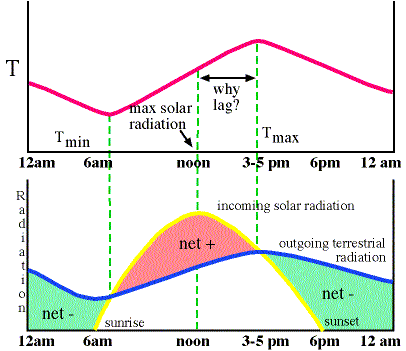Daily Temperature Variations - Net Radiation
The net radiation determines whether the surface temperature rises, falls, or remains the same:
net radiation = incoming solar - outgoing IR
If the net radiation > 0, surface warms ( 6 AM - 3-5 PM)
if the net radiation < 0, surface cools (3-5 PM - 6 AM)
This also explains why the warmest part of the year is in July/August, not on 21 June during the summer solstice.
QUESTIONS FOR THOUGHT:
1. How would the lag in daily temperature experienced over land compare to the daily temperature lag over water? Draw diagrams for each!!
2. The average temperature in San Fransicso, CA for December, January, and February is 11°C. During the same three-month period the average temperature in Richmond, Virtginia is 4°C. Yet, San Francisco and Richmond have nearly the same yearly total of heating degree-days. Explain why.
3. On a warm summer day, will a city in New Jersey or New Mexico experience a larger diurnal temperature variation? Explain.
